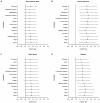Racial disparities in the survival time of patients with hepatocellular carcinoma and intrahepatic cholangiocarcinoma between Chinese patients and patients of other racial groups: A population-based study from 2004 to 2013
- PMID: 30546445
- PMCID: PMC6256729
- DOI: 10.3892/ol.2018.9550
Racial disparities in the survival time of patients with hepatocellular carcinoma and intrahepatic cholangiocarcinoma between Chinese patients and patients of other racial groups: A population-based study from 2004 to 2013
Abstract
The aim of the present study was to investigate the racial disparities in the presentation, treatment and survival time of patients with hepatocellular carcinoma (HCC) or intrahepatic cholangiocarcinoma (ICC) between Chinese and other racial groups from the Surveillance, Epidemiology, and End Results (SEER) database between January 1st 2004, and December 31st 2013. Key covariates, including clinical presentation, treatment and survival time, were recorded and compared, demonstrating the racial differences. Kaplan-Meier analysis and Cox regression models were performed to identify these disparities in survival time. A total of 30,954 patients were identified in the SEER database. Among these, 27,767 (89.7%) had HCC and 3,187 (10.3%) had ICC. In the HCC cohort, Chinese patients had the highest survival time. Compared with the mortality risk of Chinese patients, the mortality risk of Other Asian, non-Hispanic white, Hispanic and African-American patients increased by 16.8, 35.1, 28.3 and 33.3%, respectively. Compared with other groups, Chinese patients were more likely to present with localized stage, and without vascular invasion, adjacent invasion and metastasis. In the ICC cohort, the Chinese group had improved survival time, compared with the other groups following univariate analysis, although no significant differences were observed between Chinese and Other Asian and Hispanic patients following adjusting for contributing factors. Furthermore, there was no significant differences in the presentation between the groups, which differed from the HCC analysis. In conclusion, race/ethnicity was a significant independent prognostic factor in the HCC cohort, whereas it was not significant in the ICC cohort. The synergistic effect of contributing factors, including demographic, socioeconomic, biological and treatment differences, caused the racial disparity observed in primary liver cancer survival time.
Keywords: SEER database; population; primary liver cancer; racial disparities; survival analysis.
Figures






Similar articles
-
Racial/ethnic disparities in access to care and survival for patients with early-stage hepatocellular carcinoma.Arch Surg. 2010 Dec;145(12):1158-63. doi: 10.1001/archsurg.2010.272. Arch Surg. 2010. PMID: 21173289
-
Racial disparities in treatment and survival of patients with hepatocellular carcinoma in the United States.Hepatobiliary Surg Nutr. 2016 Feb;5(1):43-52. doi: 10.3978/j.issn.2304-3881.2015.08.05. Hepatobiliary Surg Nutr. 2016. PMID: 26904556 Free PMC article.
-
Race/ethnicity-specific disparities in cancer incidence, burden of disease, and overall survival among patients with hepatocellular carcinoma in the United States.Cancer. 2016 Aug 15;122(16):2512-23. doi: 10.1002/cncr.30103. Epub 2016 May 19. Cancer. 2016. PMID: 27195481
-
Socioeconomic factors and breast carcinoma in multicultural women.Cancer. 2000 Mar 1;88(5 Suppl):1256-64. doi: 10.1002/(sici)1097-0142(20000301)88:5+<1256::aid-cncr13>3.0.co;2-3. Cancer. 2000. PMID: 10705364 Review.
-
Double primary hepatic cancer (hepatocellular carcinoma and intrahepatic cholangiocarcinoma) originating from hepatic progenitor cell: a case report and review of the literature.World J Surg Oncol. 2016 Aug 17;14(1):218. doi: 10.1186/s12957-016-0974-6. World J Surg Oncol. 2016. PMID: 27535234 Free PMC article. Review.
Cited by
-
Epidemiologic and socioeconomic factors impacting hepatitis B virus and related hepatocellular carcinoma.World J Gastroenterol. 2022 Aug 7;28(29):3793-3802. doi: 10.3748/wjg.v28.i29.3793. World J Gastroenterol. 2022. PMID: 36157533 Free PMC article. Review.
-
Hispanic Individuals are Underrepresented in Phase III Clinical Trials for Advanced Liver Cancer in the United States.J Hepatocell Carcinoma. 2023 Jul 27;10:1223-1235. doi: 10.2147/JHC.S412446. eCollection 2023. J Hepatocell Carcinoma. 2023. PMID: 37533601 Free PMC article.
-
Survival analysis of extrahepatic cholangiocarcinoma based on surveillance, epidemiology, and end results database.Ann Hepatobiliary Pancreat Surg. 2023 May 31;27(2):151-157. doi: 10.14701/ahbps.22-090. Epub 2023 Jan 2. Ann Hepatobiliary Pancreat Surg. 2023. PMID: 36588169 Free PMC article.
-
Assessment of risk factors, and racial and ethnic differences in hepatocellular carcinoma.JGH Open. 2020 Apr 15;4(3):351-359. doi: 10.1002/jgh3.12336. eCollection 2020 Jun. JGH Open. 2020. PMID: 32514436 Free PMC article. Review.
-
Survival Analysis of Cancer Patients in North Eastern Nigeria from 2004 - 2017 - A Kaplan - Meier Method.Open Access Maced J Med Sci. 2019 Feb 22;7(4):643-650. doi: 10.3889/oamjms.2019.109. eCollection 2019 Feb 28. Open Access Maced J Med Sci. 2019. PMID: 30894929 Free PMC article.
References
-
- Artinyan A, Mailey B, Sanchez-Luege N, Khalili J, Sun CL, Bhatia S, Wagman LD, Nissen N, Colquhoun SD, Kim J. Race, ethnicity, and socioeconomic status influence the survival of patients with hepatocellular carcinoma in the United States. Cancer. 2010;116:1367–1377. doi: 10.1002/cncr.24817. - DOI - PubMed
LinkOut - more resources
Full Text Sources
